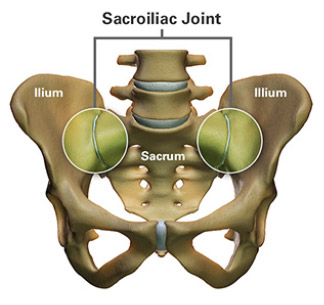Sacroiliac Joint Dysfunction FAQs
In 15-30% of cases, chronic low back pain may not be due to an issue in the low back—it may be caused by an issue with the sacroiliac joint.1, 2, 3, 4, 5
"Low back pain" is a term that is broadly used to describe pain that could have various causes including structures in the lower back, the buttocks or the pelvic region. Is your “low back pain” truly coming from your lower back?
Low back pain is a common issue that affects many people during their lifetime. There are many structures in the lower back and pelvic area that can cause pain. Most commonly, people with low back pain believe that the lumbar spine is the cause of their pain. Occasionally, hip problems can cause pain that is sometimes confused with low back conditions. Another common cause of low back pain symptoms can be the sacroiliac joint. SI joint dysfunction can be a significant contributor to pain in the lower back, pelvic region, buttocks, or legs.
Where is the sacroiliac (SI) joint?
The SI joint is located in the posterior pelvis, linking the iliac bones (pelvis) to the sacrum (lowest part of the spine above the tailbone).
What is the function of the sacroiliac joint?

The function of the SI joint is to transfer weight and forces due to movement from your legs, through the pelvis to your upper body and vice versa—acting as an anatomical shock absorber to protect the spine during activity. The primary role of the SI joint is to provide stability for the pelvis and to bear the load of the upper body.
What causes SI joint pain?
Trauma and degeneration are two leading causes of SI joint dysfunction. Sacroiliac joint trauma can occur during motor vehicle accidents, falls on the buttocks, lifting and/or twisting, pregnancy and childbirth. Sacroiliac joint degeneration can occur as a result of previous lumbar spine surgery, stresses to the SI Joint due to leg length differences, osteoarthritis, and prior infection of the SI joint.
How is SI joint dysfunction diagnosed?
A sacroiliac joint exam includes:
- Consideration of a patient’s health history and symptoms
- Asking the patient to point to where it hurts (Fortin Finger Test)6
- Physical examination, including provocative tests (stressing the joint in an attempt to recreate the pain)
- Diagnostic injections (injecting anesthetic into the joint to see if the pain goes away).
What are some of the most common symptoms of SI joint dysfunction?
- Lower back pain (below L5)
- Sensation in lower extremity; pain, numbness, tingling, weakness
- Pelvis/buttock pain
- Hip/groin pain
- Feeling of leg instability (buckling, giving way)
- Disturbed sleep patterns due to pain
- Disturbed sitting patterns (unable to sit for long periods, sitting on one side)
- Pain when going from sitting to standing
PATIENTS WITH SI JOINT DYSFUNCTION COMMONLY EXPERIENCE PAIN DURING THESE ACTIVITIES
How is the iFuse Implant System® used to treat SI joint dysfunction?
The iFuse Procedure is a minimally invasive surgery that stabilizes and fuses the SI joint. Typically, a surgeon places three small triangular titanium implants across the joint, and the triangular shape and strength of the implant resists movement and rotation of the joint. iFuse is the only device for treatment of SI joint dysfunction that is backed by significant published clinical evidence, including two randomized controlled trials.
How can you learn more about SI joint dysfunction, symptoms, treatment, and the iFuse Implant System?
Prospective patients should speak to their doctor and can learn more about sacroiliac joint dysfunction, treatment options, and the iFuse Implant System via SI-BONE’s website, www.si-bone.com. For indications, risks, and safety information about the iFuse Implant System, visit www.si-bone.com/risks.




